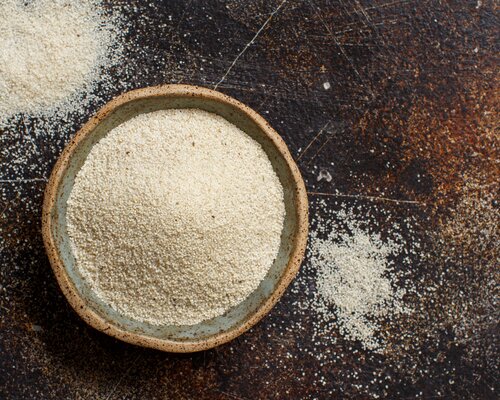Fonio
Digitaria exilis and Digitaria iburua
Crop Overview
Fonio is a fast-growing, drought-resistant annual cereal. The two most important types of fonio are white fonio (Digitaria exilis (Kippist) Stapf), which is the more widely cultivated species, and black fonio (Digitaria iburua Stapf), which is grown mainly in Nigeria. White fonio is also known as fonio millet, hungry rice or acha rice, while black fonio is also known as iburu.
Fonio is native to West Africa, where it was domesticated more than 5,000 years ago. It is an important subsistence crop in Guinea, Nigeria, Mali, Côte d’Ivoire and Burkina Faso.
Characteristics, Cultivation and Agricultural Practices
Fonio thrives in arid, sandy soils with limited rainfall, making it well-suited for the dry Sahelian regions of West Africa. It is also tolerant of flooding, making it an exceptionally resilient crop in the face of extreme weather events. It grows in marginal, poor soils and requires little to no fertilizer or pesticide input. However, it is prone to fungal diseases, including rust.
Fonio is considered the world’s fastest-maturing cereal, producing grain in as little as six weeks after planting. It is thus often the first grain harvested in the growing season, providing food before other crops such as sorghum and maize are harvested. Fonio has a relatively low susceptibility to pests and diseases, which, combined with its short growing period (6–8 weeks), makes it one of the most adaptable and resilient grains.
Under optimal conditions, fonio yields around 1.5 tonnes per hectare, although actual yields of 500–800 kg per hectare are more common due to limited inputs (FAOSTAT). Fonio is typically cultivated in small-scale, traditional farming systems, often as part of crop rotations or intercropped with legumes to enhance soil fertility. Challenges of harvesting and labor-intensive processing limit large-scale production.
Nutritional, Economic and Medicinal Value
Fonio is an excellent source of protein, and is rich in essential amino acids that are lacking in rice, maize and sorghum. It also contains higher levels of iron, zinc, magnesium and vitamin B6 than other cereals, and is a good source of fiber, calcium, copper and folate. Fonio is naturally gluten-free, making it an appealing choice for people with celiac disease or gluten sensitivity. The grain’s low glycemic index benefits diabetics and helps with blood sugar control.
Fonio is a staple in West African diets, particularly valued in rural areas for its versatility in dishes such as porridges, couscous and soups and in making bread. It is also used in brewing beer.
Cultural Importance
Fonio holds deep cultural significance in many West African societies, often linked to rituals, ceremonies and traditional gatherings. In some cultures, it is considered a sacred food, used in offerings to ancestors and deities, and is associated with fertility, prosperity and community unity. It is often prepared during special occasions, such as weddings and harvest festivals, where it symbolizes wealth and blessings.
Gender Perspectives
Processing fonio is extremely labor-intensive and carried out almost exclusively by women. As a result, women tend to prefer other cereals that are easier to process. As with many subsistence crops, women also bear the brunt of the work of growing the crop.
Women currently dominate the fonio supply chain, and improving access to markets and training could help empower women, boost livelihoods and advance gender equality in rural areas.
Why is the Crop Underutilized?
Despite its resilience and nutritional advantages, fonio has received little attention from research and development. Challenges include low yield, small grain size, lodging, shattering and seeds that mature unevenly. Processing is challenging due to the small seed size and fine husk, making it labor-intensive and costly without mechanized support. Additionally, a lack of infrastructure and investment in fonio production has hindered its commercialization on a larger scale, keeping it as a niche crop rather than a mainstream grain.
Efforts to increase awareness about fonio’s nutritional value, combined with innovations in processing technology, are gradually expanding its appeal and market potential. Ongoing research into mechanized harvesting and processing could reduce costs and improve production scalability. As demand grows in international markets, the potential for increasing fonio production and expanding markets also grows, with support from agricultural policies focused on Indigenous grains and climate-resilient crops.
Diversity Available in Genesys
Genesys, the online information platform about plant genetic resources for food and agriculture conserved in genebanks worldwide, lists only 608 seed samples of white fonio, most of which are held at:
- Institut d’Economie Rurale, Mali - 273 samples.
- Unité de Génétique, Biotechnologie et Science des Semences, Benin - 200 samples.
- National Centre for Genetic Resources and Biotechnology, Nigeria - 79 samples.
Over half are shown as traditional varieties or landraces, but the status of many is not specified. Genesys lists only 46 samples of black fonio, 45 of which are held in the Unité de Génétique, Biotechnologie et Science des Semences, Benin. Most are shown as being traditional varieties or landraces.
Current Breeding Efforts
Breeding efforts on fonio are currently very limited.



